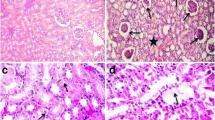Abstract
The purpose of our study was to investigate the effect of water pH in the genesis of cardiovascular injury caused by cadmium poisoning. For this study, 90 male Wistar rats were used, divided into six groups: A, 15 rats that received 400 mg/l cadmium chloride (CdCl2) in drinking water at a neutral pH of 7.0; B, 15 rats that received CdCl2 (400 mg/l) in drinking water at an acidic pH of 5.0; C, 15 rats that received CdCl2 (400 mg/l) in drinking water at a basic pH of 8.0; D, 15 rats that received water at an acidic pH of 5.0; E, 15 rats that received water at a basic pH of 8.0; and F, 15 rats that received water at a neutral pH of 7.0. All animals were euthanized after 6 months. We collected the heart and aorta from each rat for microscopic analysis. No microscopic changes were observed in the hearts. In the aorta, fatty streaks appeared in a large proportion of animals in groups A (50 %) and B (46 %), but fatty streaks appeared in a smaller minority of animals in groups C (15.3 %), D (0 %), E (7 %), and F (13.3 %) (p < 0.05). Cadmium exposure caused the development of fatty streaks in the aorta of animals and the exposure to this metal in basic pH decreased the formation of these lesions.


Similar content being viewed by others
References
Bernhoft RA (2013) Cadmium toxicity and treatment. Scientific World Journal. doi:10.1155/2013/394652
CONTAM (2009) Scientific opinion of the panel on contaminants in the food chain on a request from the European commission on cadmium in food. EFSA J 980:1–139
Clemens S, Aarts MG, Thomine S, Verbruggen N (2013) Plant science: the key to preventing slow cadmium poisoning. Trends Plant Sci 18:92–99. doi:10.1016/j.tplants.2012.08.003
Ferramola ML, Pérez Díaz MF, Honoré SM, Sánchez SS, Antón RI, Anzulovich AC, Giménez MS (2012) Cadmium-induced oxidative stress and histological damage in the myocardium. Effects of a soy-based diet. Toxicol Appl Pharmacol 265(3):380–389
Järup L, Akesson A (2009) Current status of cadmium as an environmental health problem. Toxicol Appl Pharmacol 238:201–208. doi:10.1016/j.taap.2009.04.020
Knoflach M, Messner B, Shen YH, Frotschnig S, Liu G, Pfaller K, Wang X, Matosevic B, Willeit J, Kiechl S, Laufer G, Bernhard D (2011) Non-toxic cadmium concentrations induce vascular inflammation and promote atherosclerosis. Circ J 75(10):2491–2495
Menezes LM, Freitas MPM, Gonçalves TS (2009) Biocompatibility of orthodontic materials: myth or reality? Rev Dental Press Ortodon Ortop Facial 14(2):144–147
Messner B, Bernhard D (2010) Cadmium and cardiovascular diseases: cell biology, pathophysiology, and epidemiological relevance. Biometals 23:811–822. doi:10.1007/s10534-010-9314-4
Messner B, Knoflach M, Seubert A, Ritsch A, Pfaller K, Henderson B, Shen YH, Zeller I, Willeit J, Laufer G, Wick G, Kiechl S, Bernhard D (2009) Cadmium is a novel and independent risk factor for early atherosclerosis mechanisms and in vivo relevance. Arterioscler Thromb Vasc Biol 29(9):1392–1398. doi:10.1161/ATVBAHA.109.190082
Mlynek V, Skoczynska A (2005) The proinflammatory activity of cadmium. Postepy Hig Med Dosw 59:1–8
Motta ACF, Migliari DA, Gioso MA, Komesu MC, Sala MA, Lopes RA (2004) The carcinogenic potential of cadmium in the palatal and gingival epithelium of rats. A morphologic and morphometric analysis. Br J Vet Res AnimSci 41:183–188
Nai GA, Golghetto GM, Estrella MPS, Teixeira LDS, Moura FC, Bremer Neto H, Parizi JLS (2015) Influence of pH of water in the genesis of cancer in cadmium poisoning: an experimental study in rats. Histol Histopathol 30:61–67
Navas-Acien A, Tellez-Plaza M, Guallar E, Muntner P, Silbergeld E, Jaar B, Weaver V (2009) Blood cadmium and lead and chronic kidney disease in US adults: a joint analysis. Am J Epidemiol 170:1156–1164
Nawrot TS, Staessen JA, Roels HA, Munters E, Cuypers A, Richart T, Ruttens A, Smeets K, Clijsters H, Vangronsveld J (2010) Cadmium exposure in the population: from health risks to strategies of prevention. Biometals 23:769–782. doi:10.1007/s10534-010-9343-z
Paiva FP, Mafilli VV, Santos ACS (2005) Course handling of laboratory animals. Fundação Osvaldo Cruz. Centro de Pesquisas Gonçalo Muniz. Disponível em: http://www.bioteriocentral.ufc.br/arquivos/apostilha_manipulacao.pdf. Acesso em 03 jun 2012
Tellez-Plaza M, Navas-Acien A, Menke A, Crainiceanu CM, Pastor-Barriuso R, Guallar E (2012) Cadmium exposure and all-cause and cardiovascular mortality in the U.S. general population. Environ Health Perspect 120(7):1017–1022
WHO (1992) World Health Organization. Environmental Health Criteria, cadmium, vol 134. World Health Organization, Geneva
Acknowledgments
The authors thank Edvaldo Mamede dos Santos for solution preparation
Compliance with Ethical Standards
ᅟ
Conflict of interest
This research received no grant from any funding agency in the public, commercial, or not-for-profit sectors. The authors declare that there is no conflict of interest.
Research involving animals
All procedures performed in studies involving animals were in accordance with the ethical standards of the institution or practice at which the studies were conducted.
Author information
Authors and Affiliations
Corresponding author
Rights and permissions
About this article
Cite this article
Nai, G.A., Golghetto, J.J., Estrella, M.P.S. et al. pH Dependence of Cadmium-Contaminated Drinking Water on the Development of Cardiovascular Injury in Wistar Rats. Biol Trace Elem Res 165, 81–85 (2015). https://doi.org/10.1007/s12011-014-0216-0
Received:
Accepted:
Published:
Issue Date:
DOI: https://doi.org/10.1007/s12011-014-0216-0




